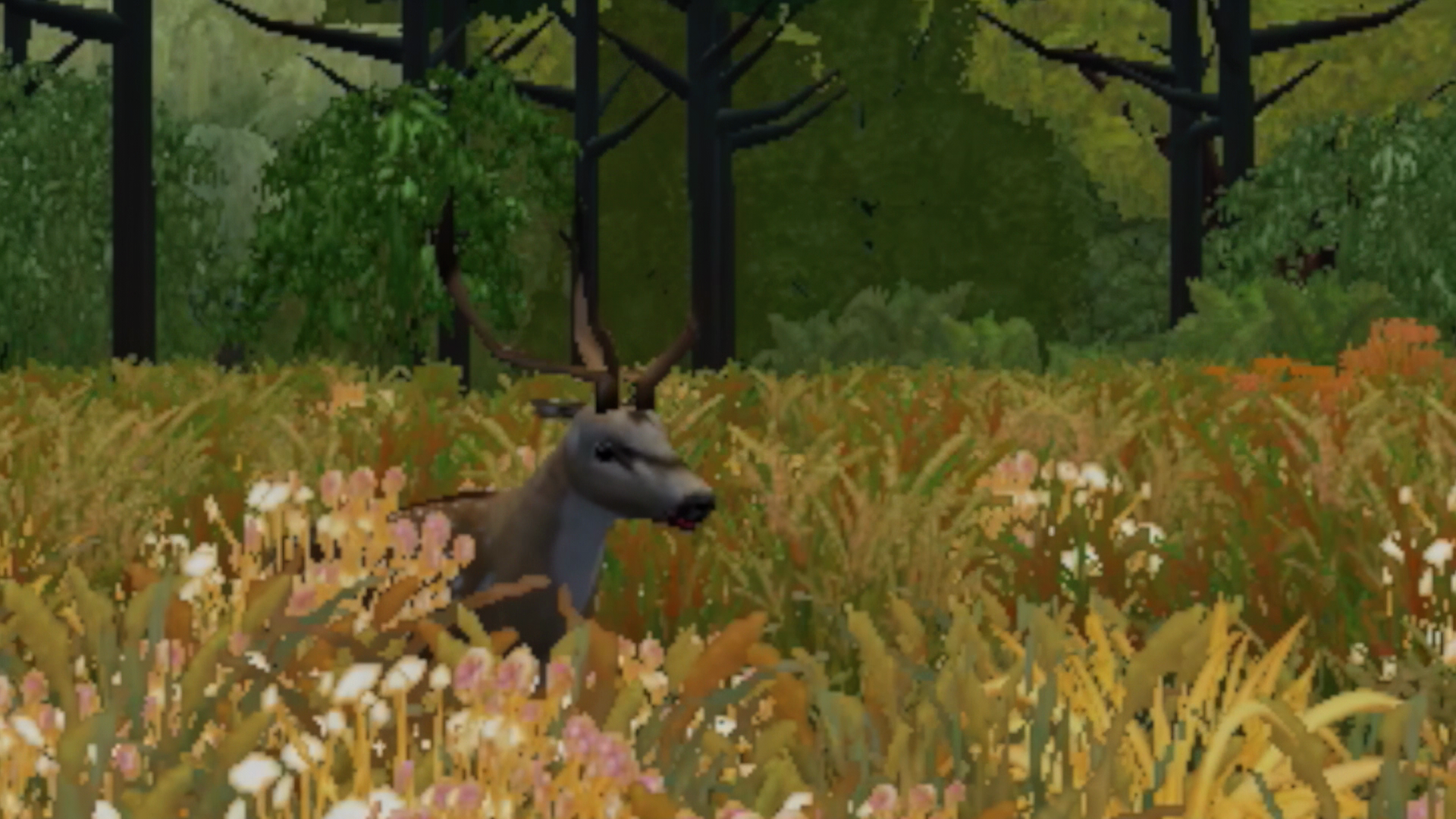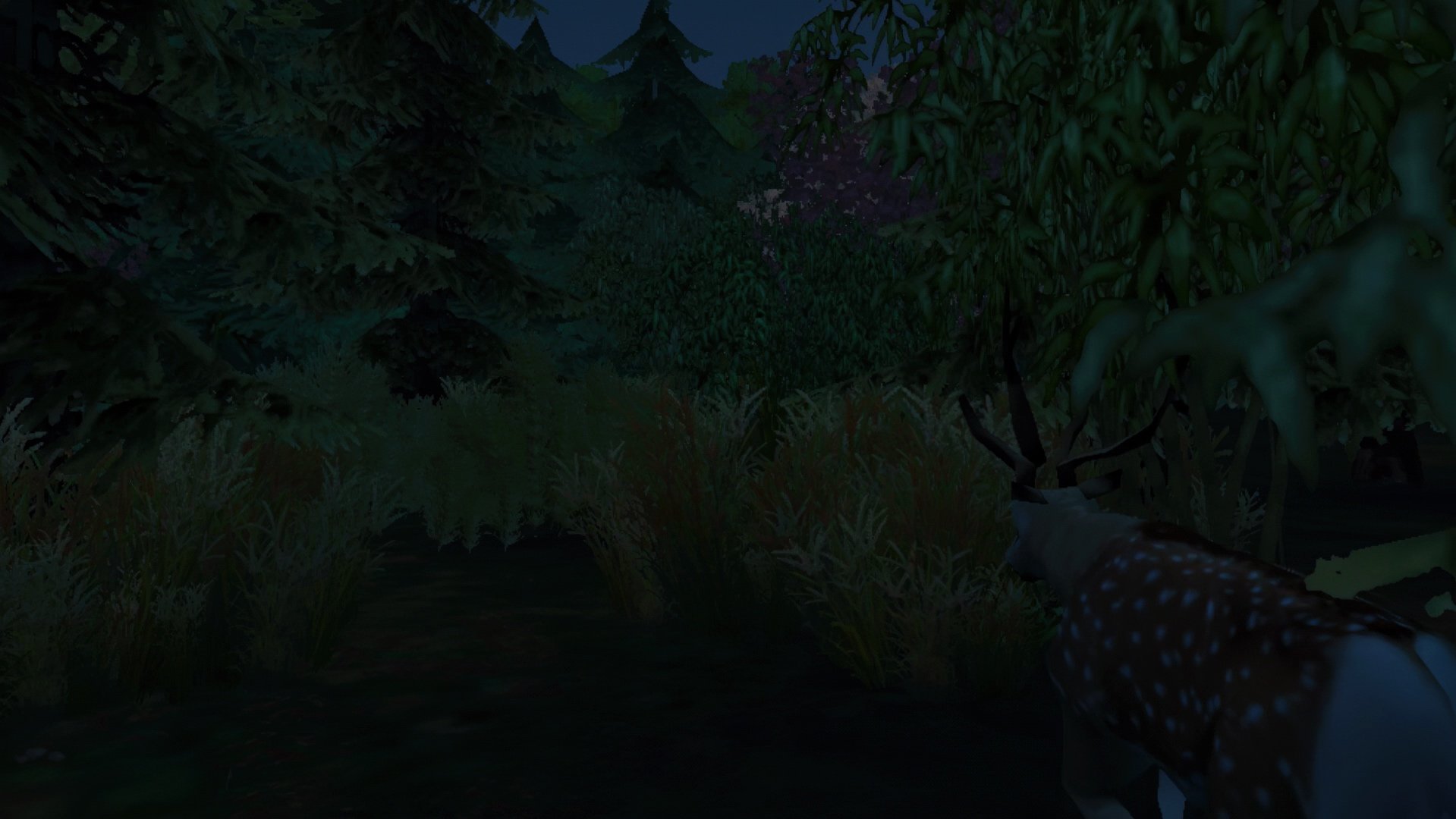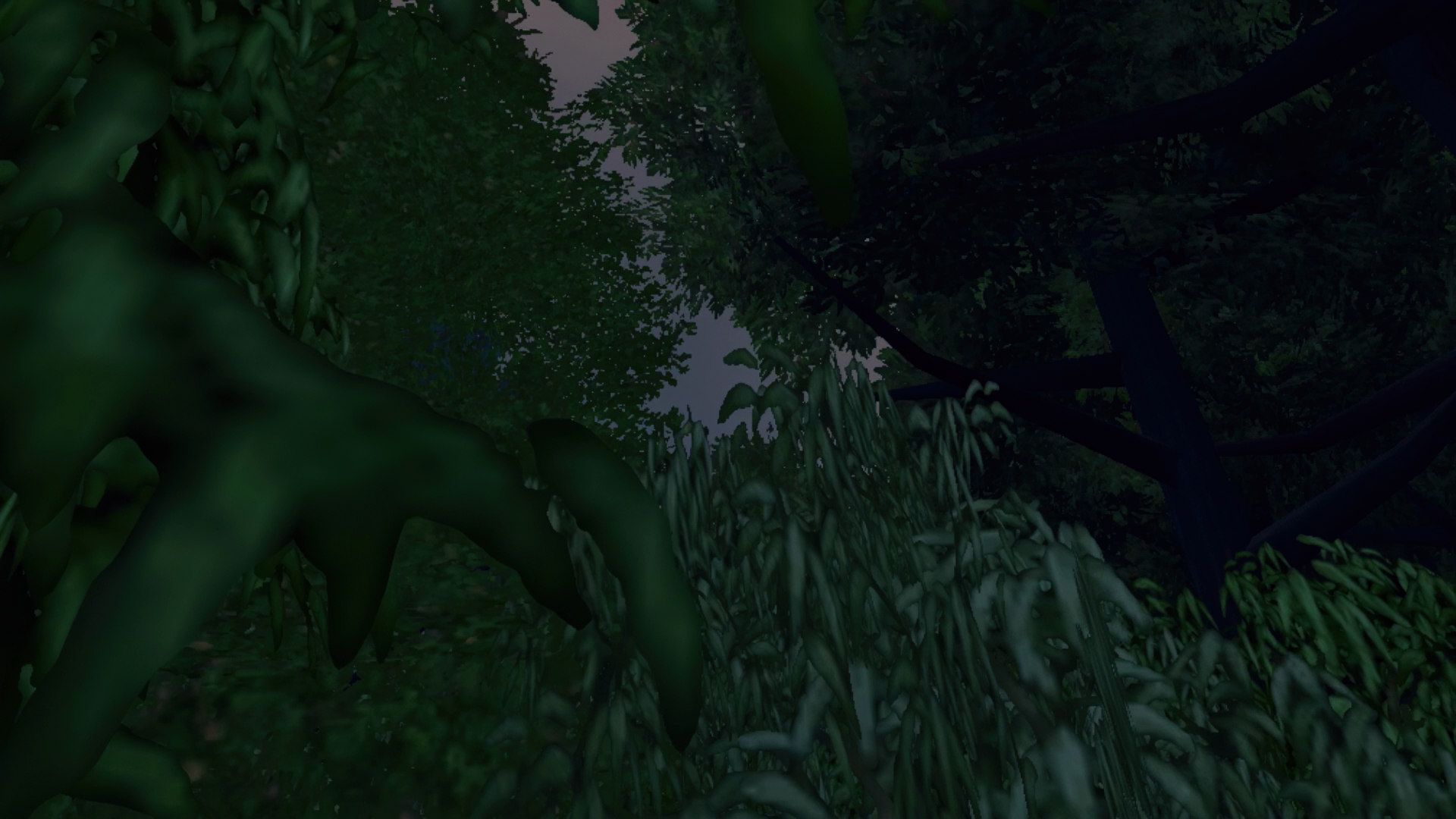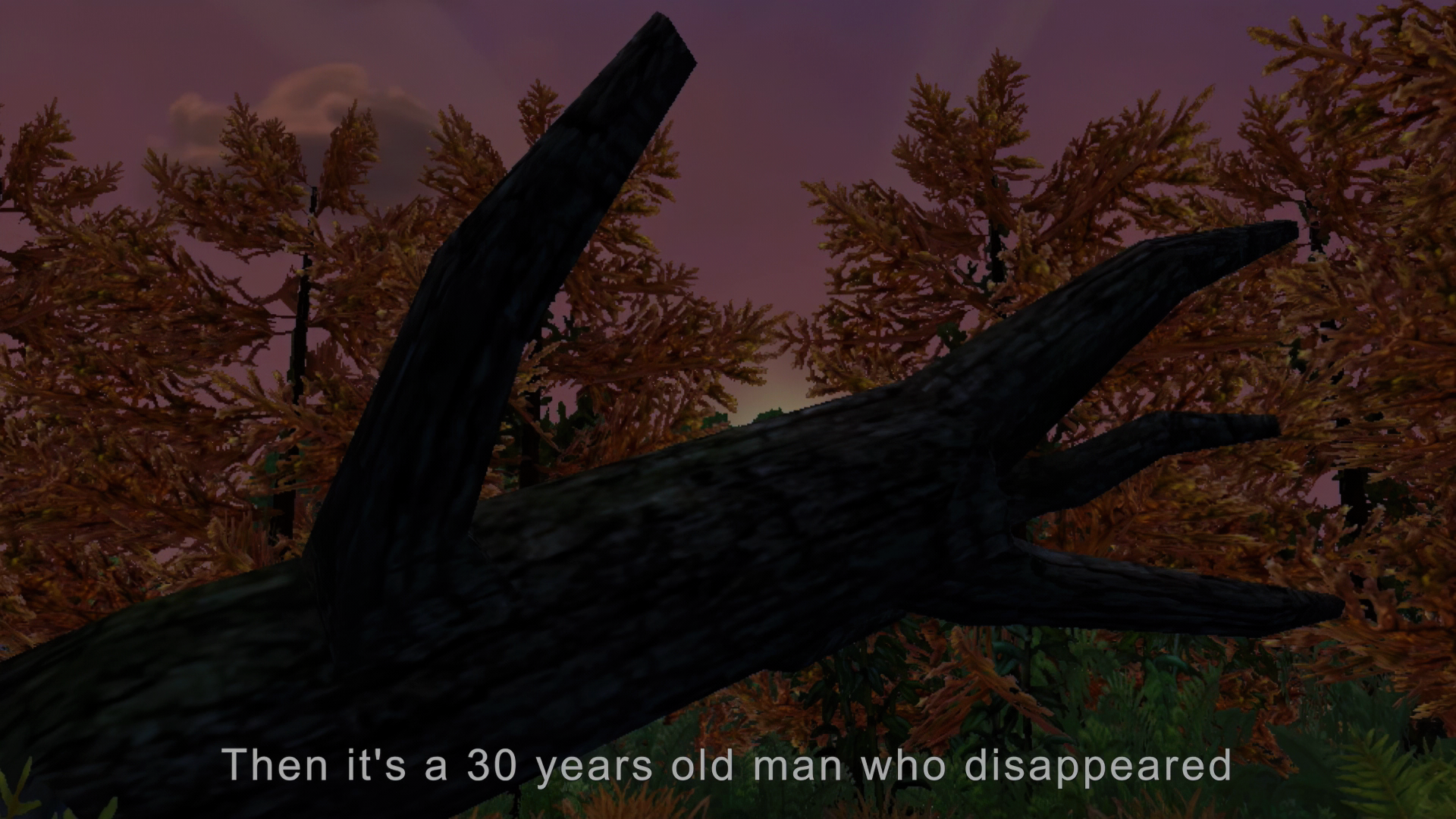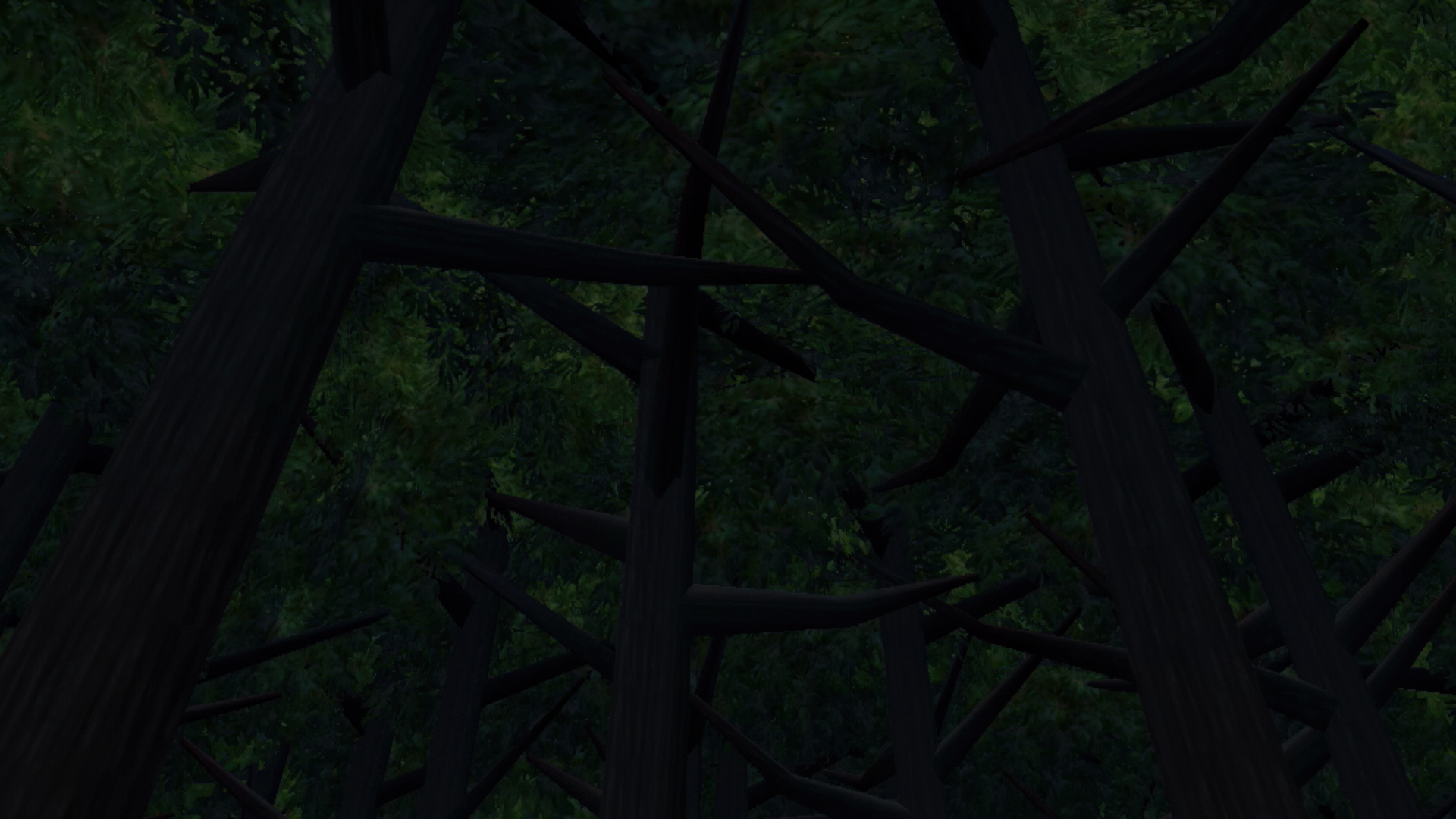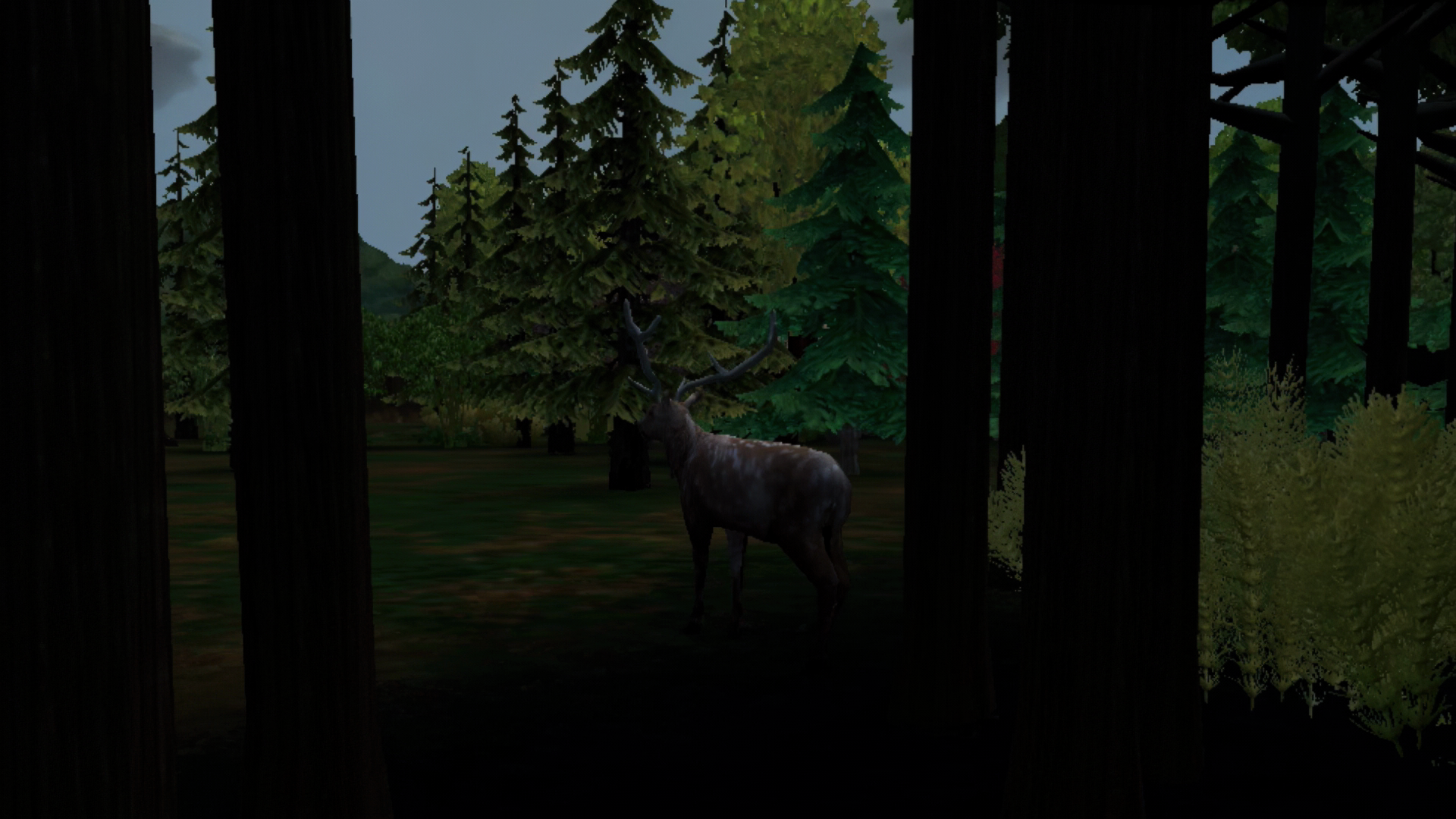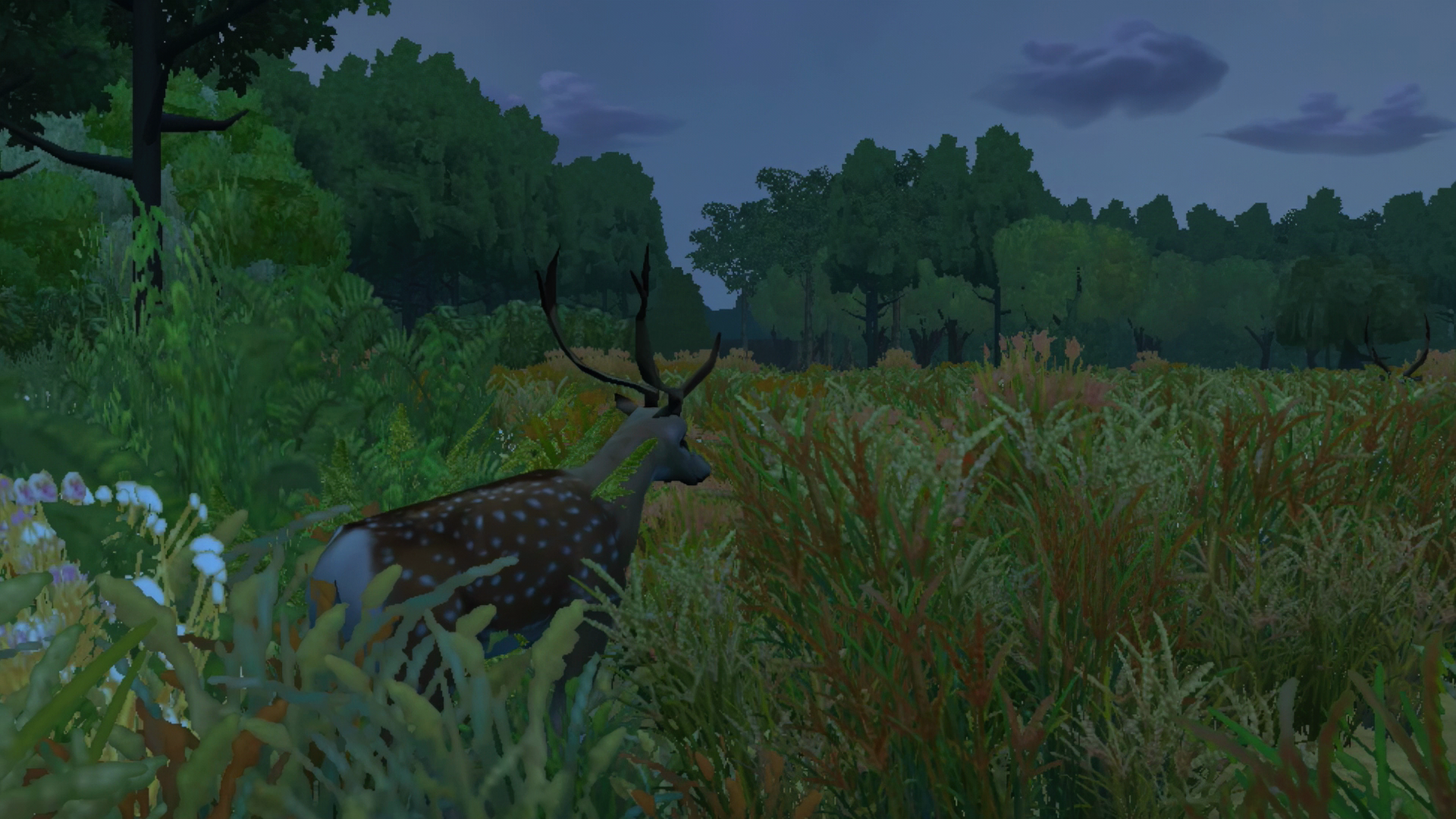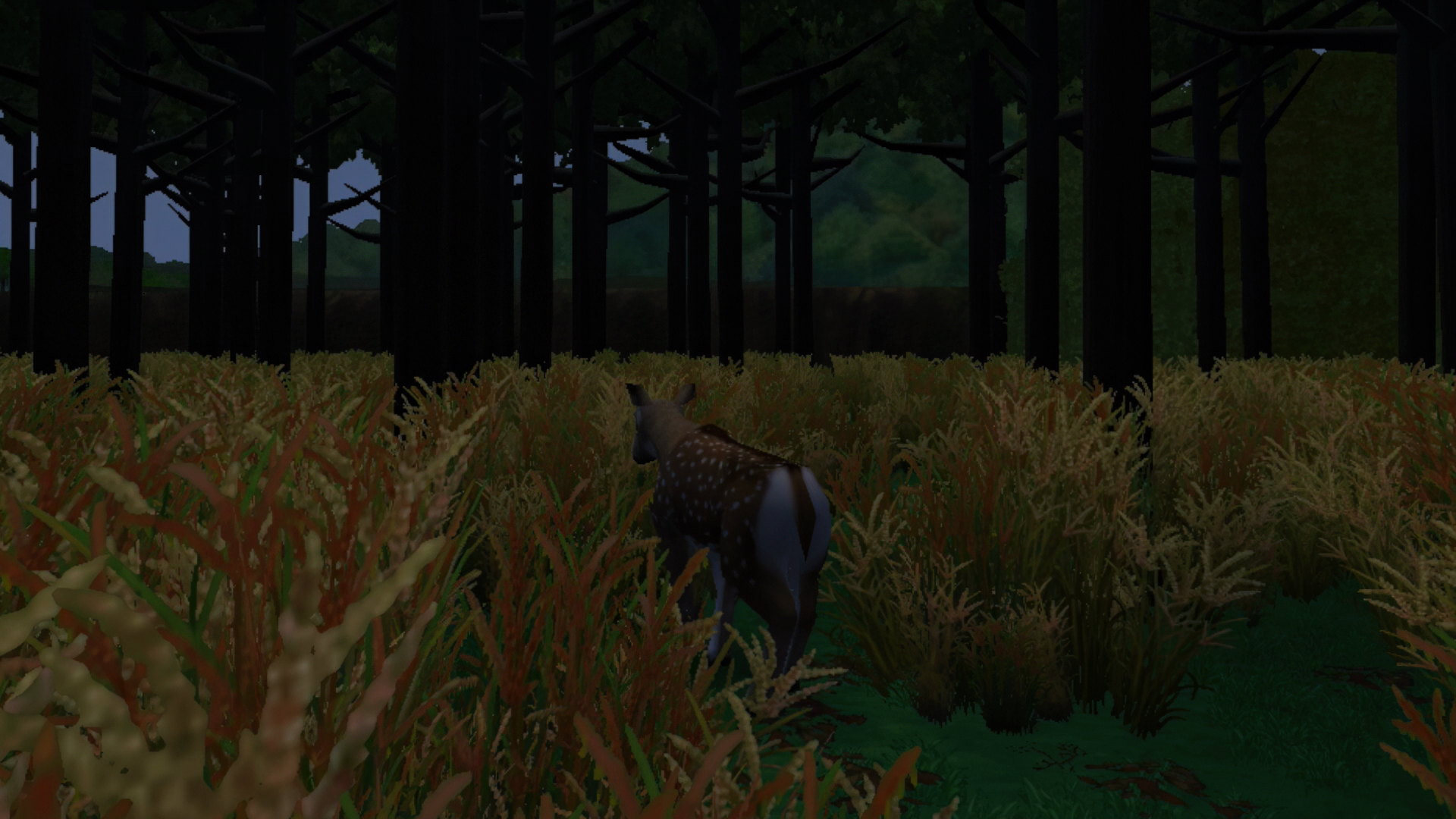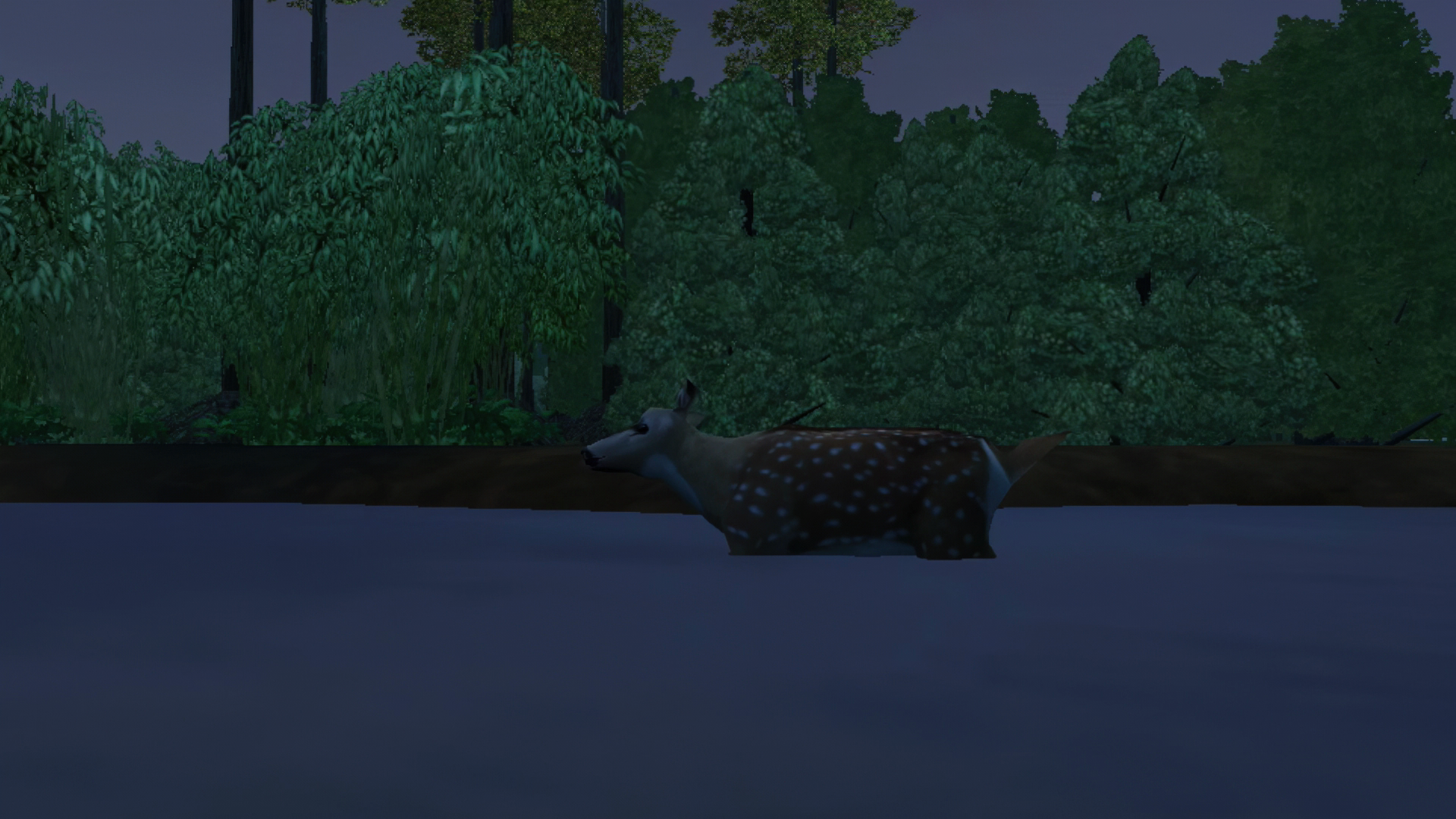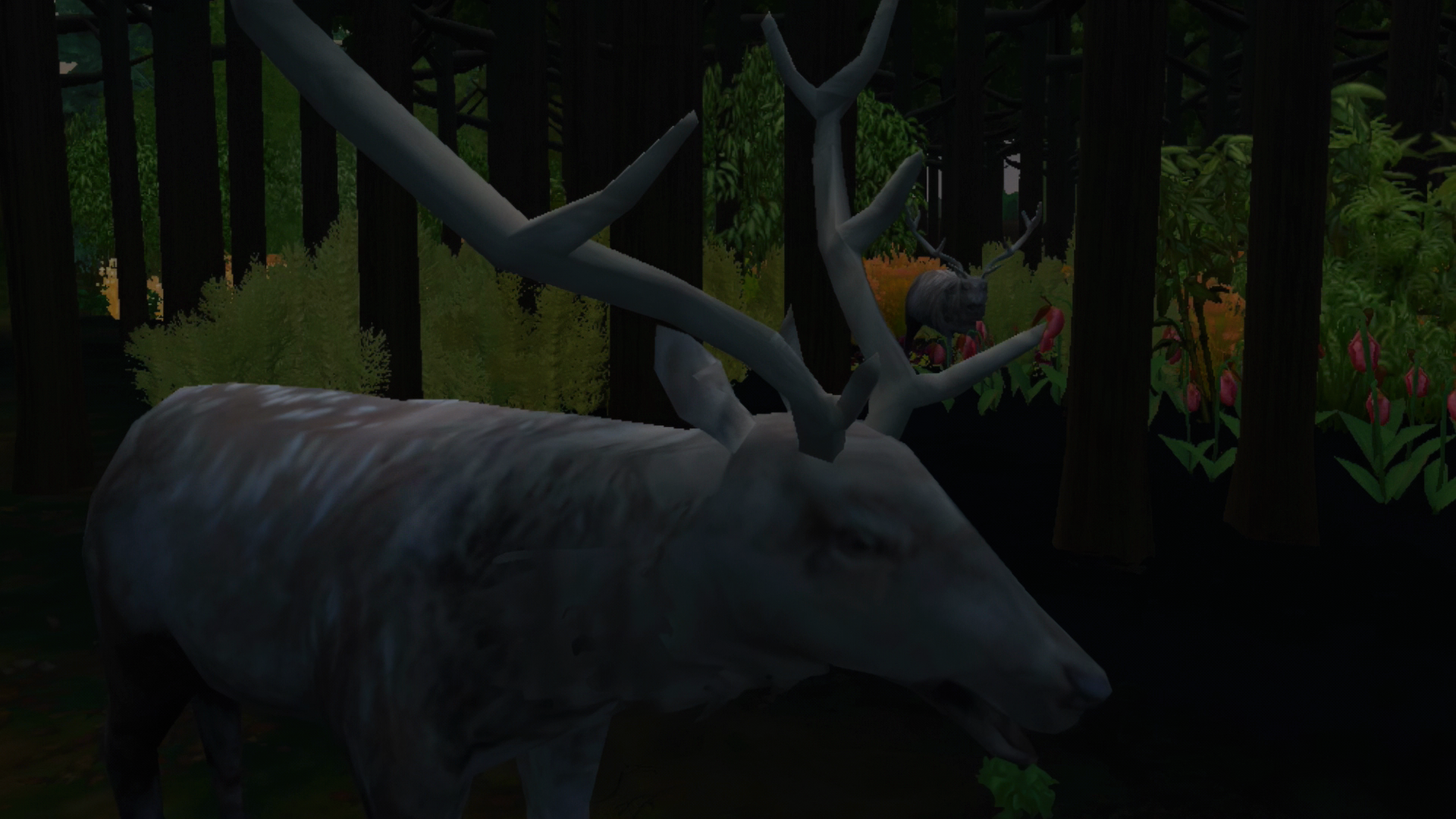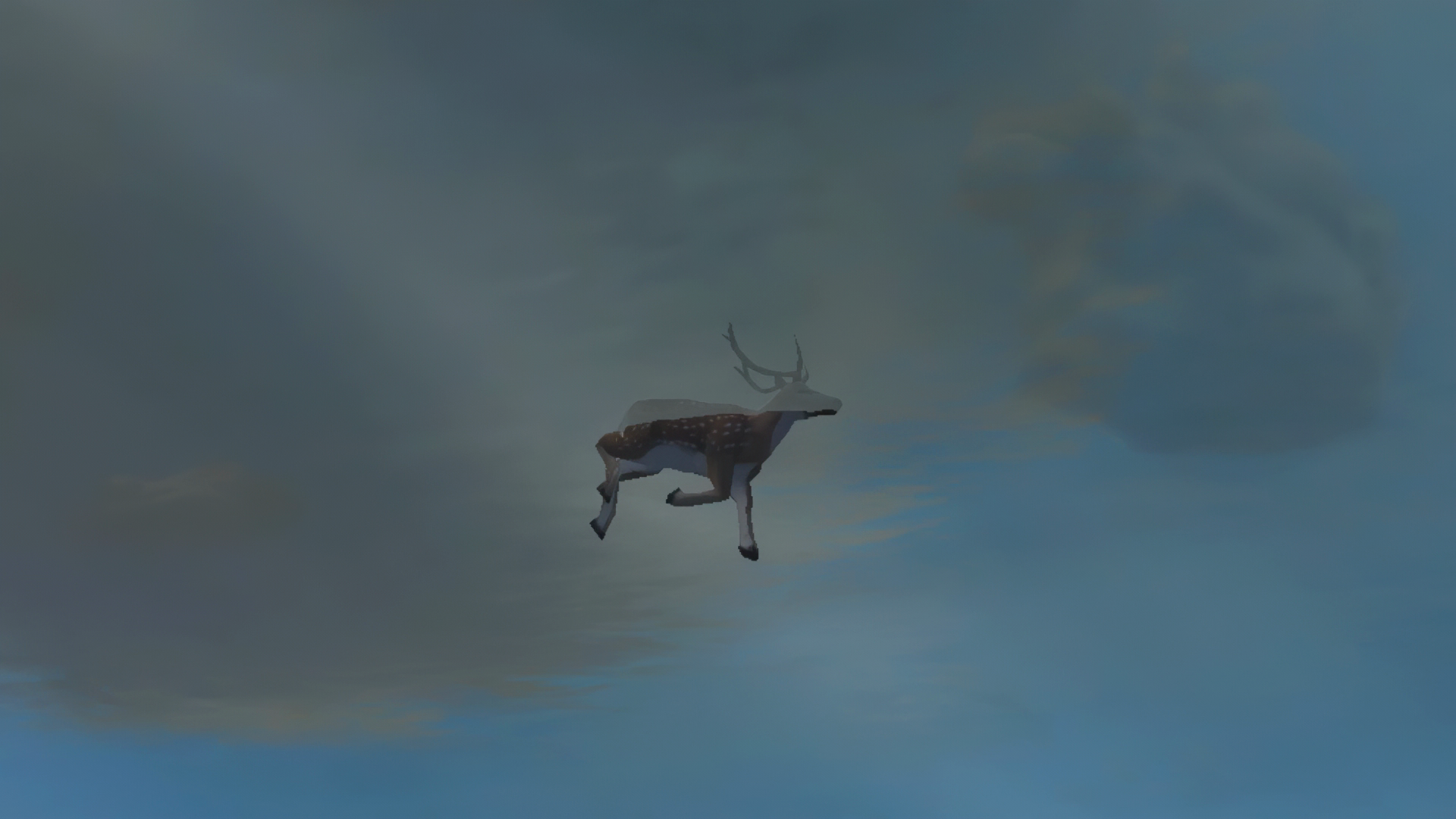Lullaby
digital video, color, sound (1920 x 1080), color, sound, 11’ 51”, 2019, France
Created by Merlin Dutertre
Developed with(in) Zoo Tycoon 2, Lullaby is set into a magic forest where people are mysteriously transformed into animals. The metamorphosis proves to be therapeutic as the former human animals are finally at peace.
With cinematic flair, Merlin Dutertre’s oeuvre weaves ethereal narratives and unique visuals, often unfolding within immersive video game worlds. At Paris 8 University, he honed an acute comprehension of the interplay between art and technology, which he channels into crafting transcendent experiences that break norms and blend genres. By seamlessly fusing found footage with virtual domains, Dutertre’s films redefine visual storytelling, harnessing his passion for the digital medium. Marked by an atmosphere of serenity and surrealism, his meticulously framed works invoke tranquility and contemplation. Lullaby and Saule Pleureur exemplify his creative acumen, guiding audiences through territories where the extraordinary and ordinary intertwine, where real and virtual dimensions harmonize. Based in Paris, Dutertre continues molding innovative and evocative films that reveal a distinct artistic vision.
Matteo Bittanti: Your time at Paris 8 University shaped you as an artist. What were those formative years like? Your graduation project, Transparent (2021), blended video game and real footage, foreshadowing your signature style. How was Transparent received at the time? Mixing real and virtual worlds has become a hallmark of your oeuvre. What draws you to juxtaposing these realms?
Merlin Dutertre: During my five-year tenure at Paris 8 University, I immersed myself in the world of cinema. This vibrant academic journey not only honed my skills but also fostered my creative spirit. One of the significant milestones during this period was the creation of Lullaby, and a few other found footage films. Paris 8 University stands as a haven of artistic liberty, offering an environment where my horizons expanded significantly. It was within these hallowed halls that I delved deep into the realm of experimental cinema, a journey that led me to the intriguing realm of found footage. I began to seamlessly weave together fragments from various sources, including video game footage and captivating discoveries on YouTube.
The culmination of this transformative phase was Transparent, a film that marked the pinnacle of my academic path. Crafted with humble resources, the film came to life against the backdrop of my upbringing, with some scenes elegantly unfolding within my parents’ cherished abode. Although Transparent didn’t enjoy an extensive showcase beyond the academic sphere, its true value lies in the wealth of insights it granted us. Notably, the experience paved the way for a subsequent collaboration, wherein the majority of our dedicated team reconvened to create another compelling short film just this past April.
Transparent embarks on its visual journey with meticulously crafted Sketchup shots, portraying an infinite expanse of suburban housing estates. As we select a single dwelling, the film’s narrative intimately entwines with the chosen abode, capturing more than mere brick and mortar. These initial 3D sequences transcend the concept of a house, encapsulating an entire ethos. The cinematic voyage then seamlessly transitions into the realm of “real” footage, as my characters venture into the vacant nocturnal house.
Matteo Bittanti: Could you elaborate on your personal connection with the medium of video games? How do you perceive video games as cultural artifacts? Additionally, could you share when you were first introduced to the concept of machinima?
Merlin Dutertre: Growing up, video games occupy a significant part of my life. I had a collection of familiar titles that I would immerse myself in repeatedly. Many of these gaming memories were cultivated on my uncle’s PlayStation 2 and later on the PlayStation 3, where I found myself engrossed in the enchanting worlds of Little Big Planet and its sequel during my middle school years.
Sandbox games, such as Little Big Planet, Spore, Minecraft, and presently Animal Crossing: New Horizons, have consistently held a special place in my heart. What draws me to these games is the sense of boundless freedom they offer, the limitless horizons of possibility, and the empowering feeling that I have a hand in shaping the game’s universe, both in appearance and in actions. Zoo Tycoon was obviously influential as well and led me to the creation of Lullaby.
Recent times have seen some of my fondest gaming moments, particularly during the quarantine period related to Covid-19. A group of friends and I created a Minecraft server that provided an unexpected source of connection and camaraderie. The landscape we built, complete with its streets, a towering mountain, a cherished sacred tree, and even a town hall, feels as familiar to me as any IRL place. It became our social space as other forms of interaction became complicated.
As for my introduction to machinima, it’s intertwined with the fabric of growing up in the digital age. Like many individuals of my generation, YouTube was a constant companion, and I indulged in French YouTube gaming content without fully grasping the meaning and peculiar nature of machinima. However, it wasn’t until high school that the intriguing work of Jon Rafman caught my attention, particularly A Man Digging, which was filmed using Max Payne, a video game I hadn’t initially comprehended. Despite the language barrier, the enigmatic and surreal quality of Rafman’s work resonated deeply, leaving an indelible impression on me.
Furthermore, the short film Notre amour est assez puissant (Our Love Is Powerful Enough, 2014) by Jonathan Vinel left me spellbound. This discovery occurred around 2017, a period when I was deeply engrossed in my own found footage endeavors. The film’s liberating and reassuring essence resonated with me, and so did the works of Jonathan Vinel and Caroline Poggi. Their creations served as a guiding light during a time when I was navigating the world of found footage relatively independently, instilling in me a renewed sense of purpose and inspiration.
Matteo Bittanti: I completely agree. A Man Digging exemplifies the very essence of avant-garde machinima and Jonathan Vinel and Caroline Poggi’s works defies easy classifications. I appreciate that they later crafted a specific kind of game-infused cinema, with works like Jessica Forever which in my opinion perfectly captures the aesthetics and mechanics of digital games. Let’s now focus on Lullaby. What inspired you to create this unusual machinima set in a forest rather than a more traditional game environment?
Merlin Dutertre: Zoo Tycoon 2, a game that has gracefully aged over the years, now finds its place exclusively on my parents’ living room PC. During the time when I crafted Lullaby, a particular joy awaited me during my return from Paris for the holidays – the joy of revisiting Zoo Tycoon. It was in these moments that I embarked on a journey through virtual nature’s past, a landscape characterized by quirky geometric designs and fascinating animal behaviors. These digital reveries served as the initial seeds of inspiration for my debut creation, Les fantômes rêvent aussi (Ghosts Dream Too, 2018), a succinct yet compelling fusion of elements sourced from YouTube, Google Images, and my virtual expeditions within Zoo Tycoon 2.
To me, the game radiates a sense of tranquility and nostalgia, holding a place among the treasured games of my childhood. Upon revisiting it, I found myself not merely constructing zoos, but rather reveling in observing the intricate interplay among the animals, forging vast forests and expansive deserts to craft fictional natural realms, each an entity of its own. This immersive practice of crafting these imagined landscapes soon sparked the idea of cinematically capturing their essence, transforming them into sets for an artistic endeavor.
The tale behind Les fantômes rêvent aussi, an enchanting narrative set within a magical haunted forest centered around a serene lake, unfolded organically during the course of filmmaking. Each step I took in producing the film, every frame I captured, contributed to the gradual evolution of this narrative. It’s a testament to the synergy between creative expression and the medium that inspiration unfurled in tandem with the visual artistry.
In hindsight, Zoo Tycoon 2 emerges as an unexpected ally for the creation of machinima. Remarkably versatile, it stands as more than a game; it’s a near-complete 3D software, a canvas onto which one can paint natural landscapes and breathe life into diverse animal inhabitants. The boundless freedom it affords aligns seamlessly with the ambitions of machinima, empowering creators to conjure realms limited only by imagination.
Matteo Bittanti: Working with an old, if not obsolete and yet functioning piece of software, has some advantages but also limitations. Can you describe the creative process and your use of Zoo Tycoon 2? What was the most challenging aspect of using this video game to create this machinima? Were there any constraints you had to work around?
Merlin Dutertre: As previously mentioned, Zoo Tycoon 2 unfolds as a context of (almost) limitless creative liberty. My process began with the crafting of a forest setting, an intricate mosaic of trees and plants that resonated with my vision. As I wove the narrative, I introduced the animals into this digital habitat. What struck me most was their autonomous behavior, akin to non-playable characters (NPCs) in a video game, charting their own course without my direct intervention. This dynamic mirrored the process of documenting real-world wildlife, casting my role in Zoo Tycoon 2 as that of a documentarian.
A peculiar beauty underpins the filming process within Zoo Tycoon 2. Unlike traditional video game setups where you inhabit a character, here you navigate the virtual landscape with a camera, mirroring the art of cinematography in real-world contexts. It’s intriguing how, despite initiating the arrangement of animals like a divine architect, the subsequent unfolding of their interactions feels unscripted and organic – much like observing animals in their natural milieu. This approach granted an “authentic”, unscripted essence to the footage.
I found this method of creation wonderfully liberating. Roaming the digital forest, my lens would focus on captivating moments as they emerged – the graceful movement of a deer or the subtle interplay between animals. The wealth of footage I captured was substantial, although only a fraction of it made its way into the final production. Editing and scriptwriting occurred in tandem, sculpting the narrative in response to the visual flow.
However, a challenge emerged when it came to sound. The game’s inherent mechanics, assuming a zoo management context, incessantly triggered notifications about animals’ enclosure proximity. This posed an obstacle to using the game’s original audio ambience, a facet I had hoped to incorporate. Collaborating with Thomas, my sound engineer from this film onwards, we embarked on the creation of bespoke ambient soundscapes for the forest depicted in the film. This collaboration ultimately enriched the auditory dimension, breathing life into the visual tapestry.
In short, Zoo Tycoon 2 ushered me into an unconventional role – that of a visual poet capturing untamed moments within a virtual wilderness. The challenges posed by sound merely ignited collaboration and innovation, forging an immersive symphony of visuals and audio that form the heart of the cinematic experience.
Matteo Bittanti: Your machinima exudes a surreal essence, yet it emanates a profound sense of tranquility and serenity, which is relatively rare. Strikingly, it maintains this mood without venturing into the realms of darkness or foreboding. As entire ecosystems collapse IRL due to climate emergency, I expect cozy” “simulators like Zoo Tycoon to become more and more popular. Could you share the strategies you employed to cultivate and sustain such a unique and harmonious atmosphere?
Merlin Dutertre: Zoo Tycoon 2 itself exudes a profound tranquility, a serenity that remains unbroken as the gentle wind sways the flora with a consistent, never overpowering force. There’s an eternal hush in the air, punctuated only by the whispers of the wind and the melodic symphony of insects. In an almost paradoxical manner, it mirrors the ambiance of a real forest, compelling us to capture the game’s intrinsic stillness and grace.
However, this serene canvas isn’t without its limitations when translating it into film. The game’s inherent camera mechanics, tethered to movement as you walk and navigate, yielded somewhat mechanical visuals. Recognizing the need to preserve the soothing and tranquil atmosphere, I consciously chose to employ static shots exclusively. This decision lent the film a quietude that mirrored the peaceful world I aimed to encapsulate.
Undoubtedly, sound plays an indispensable role in weaving the film’s emotional gravitas. The auditory components curated by Thomas, the resonant voice of Arthur, and the evocative soundtrack composed by Muuma, all converged to guide viewers toward the serenity that the characters sought. These auditory elements, meticulously chosen and harmoniously woven together, become the invisible conduits steering us into the heart of the desired tranquility.
Matteo Bittanti: Could you elaborate on your approach to filming the deer characters and imbuing them with a sense of autonomy, as if they were independent entities rather than being manipulated by human control through a joypad?
Merlin Dutertre: As I mentioned earlier, the most fascinating aspect of the game lies in the autonomy of its animals. In contrast to traditional gaming dynamics where players wield control, the denizens of this virtual world exist with an inherent independence. They embark on their own journeys, adhering to their instinctual routines: feeding, mating, nurturing offspring, and eventually passing away. This uniqueness meant that my approach to filming demanded a documentary-like sensibility.
To capture the unscripted essence of these digital creatures, I needed to adopt a different mindset, one that mirrored the work of a wildlife documentarian. Instead of orchestrating their actions through a gamepad, like a puppet master, my role became that of an observer. I had to adapt to their rhythms, meandering alongside them as they roamed their virtual realm. The process was akin to studying wildlife in their natural habitat, deciphering their behaviors, and allowing their stories to organically unfold before my lens.
By stepping back and letting the animals take the lead, their interactions gained authenticity and depth. This organic approach yielded moments of unexpected beauty and intrigue, as the deer navigated their world unencumbered by human influence. Their self-directed movements, whether they were exploring the foliage, engaging with one another, or engaging in instinctive rituals, conveyed a sense of autonomy that resonates with real-life wildlife.
In short, the process required a shift in perspective – from a traditional gamer’s control to that of an empathetic observer. The result was a delicate dance between technology and nature, culminating in visuals that mirror the genuine behavior of creatures in their environment. It’s this fusion of game mechanics and the inherent autonomy of the animals that brought about the unique and authentic quality present in the final cinematic creation.
Matteo Bittanti: The title Lullaby carries a peculiar resonance for a machinima centered around deer within a forest setting. Could you delve into the motivations behind your selection of this title and elaborate on its connection to the overarching theme and ambiance of the work? Additionally, do you perceive the machinima as a contemporary embodiment of a fairy tale? I’m curious to learn about the key sources of inspiration or influences that shaped the creation of Lullaby.
Merlin Dutertre: The title Lullaby arrived at a relatively late stage in the film’s creation process, crystallizing as an embodiment of its essence. At its core, the film explores the journey toward inner tranquility, the discovery of a haven so serene it can evoke a transformative, almost enchanting experience. The aspiration was for both the film and its soundtrack to possess a soothing quality, capable of lulling the audience into a state of peaceful repose.
Undoubtedly, the forest’s thematic presence pays homage to the realm of fairy tales. The forest, an age-old backdrop in these tales, transcends the boundaries of reality, a sanctuary where the rules of the ordinary yield to the whims of the extraordinary. Similarly, the virtual landscapes of video games, typified by the likes of Zoo Tycoon, hold a comparable allure – a refuge from the everyday, offering solace and reassurance akin to a walk through a tangible forest.
While I wouldn’t classify all machinima as fairy tales, I hold the belief that films, in general, should retain an echo of the enchantment found in these timeless narratives. The cinema that first captured my heart, films like Steven Spielberg’s E.T. and Tim Burton’s Edward Scissorhands, possess an undeniable undercurrent of fairy tale-like charm. This innocence, this ethereal quality, resonates with me deeply. Thus, with Lullaby, I aspired to infuse a sense of wonder and narrative simplicity reminiscent of stories shared with children.
Matteo Bittanti: Could you elaborate on the connection between your 2018 short film, Les Fantômes Rêvent Aussi, and its follow up, Lullaby? How do these two works intertwine or influence each other?
Merlin Dutertre: As mentioned, Lullaby emerged as a natural evolution of Les Fantômes Rêvent Aussi, both sharing a foundation in the notion of virtual forests as settings for enchanting tales. Both films resonate with the essence of ghost stories, intertwining the ethereal and the magical within their narratives. During that period, my creative impulses were profoundly influenced by the concept of mystical woodlands, where the boundaries of reality bend to accommodate any possibility.
The thematic synergy between the two works is palpable, threading a common thread of exploring the mystique of forests in a digital realm. It’s this enchanting connection that serves as the heartbeat of both films, nurturing a sense of continuity and evolution.
An intriguing parallel that unites them is their shared approach to creation. Much like Les Fantômes Rêvent Aussi, Lullaby was crafted during the editing process. The stories organically unfolded as I curated and selected footage, a testament to the collaborative dance between creation and discovery. There was no stringent script preordaining their trajectories; instead, the tales found their own voice through the assemblage of visuals, breathing life into the themes of enchantment, spectral narratives, and the allure of the digital woodland.
Matteo Bittanti: In your more recent works focusing on Pokémon – as well as other iconic characters like Spider-Man and Bugs Bunny – such as Saule Pleureur (Weeping Willow, 2021) and Saule Pleureur 2: Le retour (Weeping Willow 2: The Return, 2022), you explore the intrusion of the virtual into the real by seamlessly integrating characters from the video game series into real-world footage. Can you discuss your artistic intent behind blending these digital creatures into everyday environments and what you aim to express through this mixing of real and imagined worlds? Are commenting on the increasing colonization of the collective imaginary by corporations such as Nintendo, Sony, and Warner Bros?
Merlin Duterte: In Saule Pleureur, I embark on a creative endeavor where YouTube-sourced footage and 3D animated renditions of beloved pop culture icons seamlessly blend with real-world locales. The backdrop for the first installment is my hometown during the quarantine, while the second unfolds within the familiar confines of my parents’ house. A significant wellspring of inspiration for this cinematic journey is derived from the phenomenon of Pokémon Go and the compelling notion of these iconic characters infiltrating the mundane and the everyday.
The desire to amalgamate found footage from YouTube with authentic surroundings had simmered within me for some time. During the quarantine, while walking my dog daily, a simple yet elegant solution crystallized. The intention was akin to crafting a cinematic blockbuster reminiscent of the scope of The Avengers, albeit brimming with an eclectic assembly of pop culture figures, set against the backdrop of my hometown. These vibrant 3D animated characters, strikingly colored and infused with a palpable vivacity, create a captivating collage as they coexist amidst the nuanced grays and browns of reality.
The juxtaposition of disparate visual elements within the films is both enlightening and transformative. The strikingly unusual hues and gestures of the animated characters contrast jarringly against the real-life canvas. Their movements differ, lighting conditions diverge, and the two realms refuse to harmonize seamlessly. Instead, their essence as images remains undeniable – they are revealed to be constructs of artifice, impossible to disregard as mere representations. This dynamic becomes a cornerstone, inviting viewers to engage in a constant interplay of suspended disbelief and candid awareness of their constructed nature.
Intriguingly, the choice of utilizing renowned fictional characters stems from their prevalence on YouTube, a realm where they are omnipresent. These characters, Pikachu, Spider-Man, and the like, are global cultural icons, their imagery entrenched in our collective psyche. They embody our shared childhoods and significantly shape our communal imagination. The Saule Pleureur (Weeping Willow) films manipulate these symbols, akin to playing with cherished toys plucked from the recesses of our imagination and the expanses of the internet. In this act, they unveil the capacity of the online world to manifest our shared dreams and fantasies.
Moreover, these images kindle a dialogue about copyright and ownership. The 3D-rendered figures are reproductions of reproductions, originating from various artists and iterations. They’ve transcended their creators’ grasp, both legally and culturally. They’re now open to our whims, ready to be reimagined and repositioned as we see fit, a testament to the malleability of contemporary digital landscapes.
Lullaby
digital video, color, sound (1920 x 1080), color, sound, 11’, 51”, 2019, France
Created byMerlin Dutertre
Made with Zoo Tycoon 2 (Blue Fang Games, Microsoft Games, 2004)


